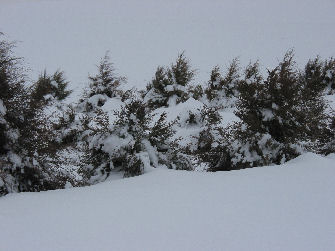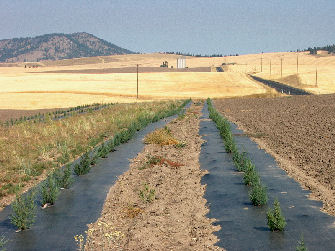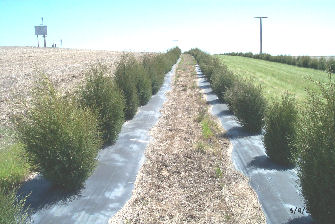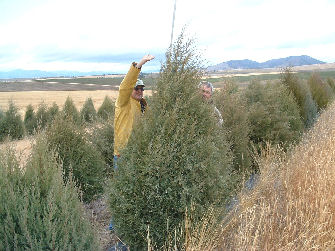Snowfences are common in those areas subject to significant snowfall. Snowfences, a specialized windbreak, are designed to divert drifting snow so it will accumulate in a predictable location. As wind blows downwind through a semi-porous tree-based snow fence, it slows, causing the snow in the air to drop and gather behind the trees, thus minimizing the amount blown onto roadways. Snow accumulation helps reduce the cost and time needed for road maintenance and snow plowing. Evergreen trees and shrubs make excellent snowfences, to reduce wind and to trap snow, although they are not commonly used in the dry land wheat-growing areas of Eastern Washington. No one knows for sure why we do not see more snowfence type windbreaks in this part of the state, but we do know that utilizing new technologies and designs, snowfences can be grown successfully.

Successful snowfence demonstrations in southeastern Idaho and dry land test plantings near Ritzville, Washington led to an interagency snowfence demonstration project on State Route 25, north of Davenport, Washington. Interagency meetings were held in 2001 and road snowdrift sites were identified on highways radiating out of Davenport. one site was selected, due in large part to a cooperative private landowner. The living snowfence was planted in April 2003 using high-quality 20 cubic inch container-grown Rocky Mountain juniper (Juniperus scopulorum) seedlings. Lumite fabric mulch (a black woven polypropylene mat available from Shaw Fabrics Inc.) was used for weed control and soil moisture conservation.

Previous unsuccessful snowfence projects in eastern Washington can be attributed to poor planning, poor seedling stock, poor planting, and inadequate care. These failures helped create an attitude that windbreaks and living snowfences are too difficult to establish in that area or that "trees will not grow here." Today, the use of fabric mulch has greatly enhanced windbreak establishment success and initial growth rates.
The USDA National Agroforestry Center in partnership with the USDA Natural Resource Conservation Service developed the cooperative living snowfence project with key state and local agencies. The project's purpose was to show the value of living snowfences in this dry cropland region and to demonstrate new establishment technology. The interagency meetings were held the year before the site was selected to inform the local agencies about living snowfence technology and to form an interagency team for project planning and installation. Much energy went into identifying snowdrift sites, field review of potential sites, and securing landowner cooperation.
METHODS
Snowfence Establishment
Sixteen snowdrift sites on Lincoln County state highways were identified by road maintenance personnel from Washington State Department of Transportation in Davenport. The Highway 25 project site is approximately nine miles North of Davenport. This is a highly traveled north/south road leading to many recreational opportunities with a prevailing Westerly wind direction. The landowner was supportive of the project and cooperated throughout the planning and installation.
The site was located in dry cropland with deep silt loam. General average precipitation for this vicinity was 16 inches per year. Deep ripping was done to prepare the locations of the tree rows before planting. A double, twin-row high-density design (Helwig, 19831) using Rocky Mountain juniper was used. This design was selected, as it has proven useful and minimizes the windbreak "foot-print." The windward twin row was located 142 feet windward (west) of the road. The leeward twin row was located 42 from the windward row. The tree-to-tree spacing within each row was 6.5 feet and the spacing between twin-rows was 8 feet. The land between the twin row pairs was seeded with Durar hard fescue, a low growing bunchgrass for site protection.
In April 2003, an interagency crew planted the trees and installed fabric mulch on each row that is approximately 880 feet long. The entire demonstration site consists of 532 trees. Larger, high-quality Rocky Mountain juniper seedlings2 were used. This larger evergreen stock has proven superior for establishment in Washington and Idaho's semi-arid regions.
Since we wanted not only to demonstrate a windbreak, but also to measure growth rates, we identified the twin-row locations in the installation as west (W) and east (E), with the east pair of rows being closer to the highway. The individual rows located within each pair of rows were identified as row one (1) and row two (2), with row two being closer to the highway, or east of row one for each location. Row E2, then, designates the row that is closest to Highway 25, and row W1 designates the row that is furthest from Highway 25. Each row was further subdivided into three equal segments, North, Middle, and South that were used to assess potential variation in tree development by north-south position within a row. Results based on these identification criteria follow in this article. Tree measurements were taken annually in October starting in 2003. Every fifth tree in each row was measured beginning with the northern-most tree and proceeding southward along the row. There were 27 trees sampled in each row, with a total 108 possible measurements for each year: 54 trees for each location, 27 trees for each row within a location, and 9 trees for each position within a row. For each sampled tree, total tree height and crown width were measured.
EXPERIMENTAL RESULTS
The primary purpose of this project was to demonstrate the feasibility and functionality of living snowfences in Eastern Washington. Nevertheless, we decided to do a small analysis to see how well the trees were growing (year by year) and to determine if there was any twin-row; row-to-row; or within-row differences. The metrics selected were total tree height, crown-width, and annual tree height and crown-width growth. Biometrics Northwest LLC of Redmond, Washington conducted the statistical analysis. Five-year results are reported here.
Total Tree Height and Annual Tree Height Growth
Mean height values - one standard error were 22.4-0.42 inches, 40.1-0.58 inches, 54.1-0.71 inches, 69.4-0.88 inches, and 79.4-1.14 inches, respectively, for measurement years 2003 through 2007. As mean tree size increased so did the variability in individual tree size, as indicated by increasing values for the standard errors over time. We feel that these values are very adequate and that windbreak functionality is partially achieved after the fifth-year.
The observed annual mean height growth rates - one standard error were 17.7-0.31 inches, 14.0-0.37 inches, 15.3-0.40 inches, and 10.0-0.48 inches, respectively, for growing years 2004 through 2007. In the last year of measurement, tree height growth has declined. See the section below addressing the potential implication of precipitation.

Total Crown-width and Annual Crown-width Growth
The average crown-width was 50 inches, which we considered excellent in the five-year period. Annual mean crown-width growth-rates varied over the four growing years, with 2004 producing an intermediate value 2005 and 2007 producing the smallest values, and 2006 producing the largest value. Differences in annual mean crown-width growth-rates among the measurement years were highly statistically significant. The observed annual mean crown width growth rates � one standard error were 12.3�0.27 inches, 7.8�0.28 inches, 20.1�0.54 inches and -3.4�0.50 inches, respectively, for growing years 2004 through 2007. Crown closure has not occurred fully, however we feel that partial functionality has been achieved after five years. In retrospect, the tree-to-tree spacing should have been 5.5 to 6 feet, not the 6.5 feet used.
Early analyses showed us that tree growth between the West and East twin-rows were significant, however after the fifth year, these differences were not found. Twin-row differences were not statistically significant from each other, nor were the within-row differences. Crown width did retract during the fifth growing season, while we do not know why with certainty; we speculate that as the trees start to compete for site resources, height growth is favored over crown width. Annual precipitation in this area was well below normal during the fifth growing season, which may have influenced these results. The drought was not so severe that it resulted in mortality however.
Funding for the BC Agroforestry Industry Development Initiative is provided by the Investment Agriculture Foundation of BC. Agriculture and Agri-Food Canada and the British Columbia Ministry of Agriculture and Lands provide funding and support for the Foundation. The Federation of BC Woodlot Associations administers the BC Agroforestry Industry Development Initiative.
Annual Growth Rates as Influenced by Precipitation
A cursory comparison of precipitation amounts, as measured in Davenport, indicated a strong correspondence between precipitation and the magnitude of the growth rate (both height growth and crown-width growth), with the 2005 and 2007 growing years producing smaller growth rates than the other two growing years. The 2006 growing year, which had the most precipitation, produced the second largest height growth rate and the largest crown-width growth-rate. This brief comparison was not intended to be definitive, but rather to suggest a possible relationship between the growth rates observed and impacts from local climate.

CONCLUSIONS
Total height growth, crown width, and survival rates were remarkable, and can be attributed to proper planning, site preparation, quality nursery stock, proper planting, annual maintenance and the use of fabric mulch. If all of these conditions are met, we feel that living snowfences show great promise in Eastern Washington and will provide service for many years. Partial functionality of twin-row Rock Mountain juniper windbreaks can be expected after the fifth growing season.
We wish to stress the importance of using fabric mulch. In this demonstration, as well as those located elsewhere, the use of fabric much is mandatory for successful establishment and growth. At this site, we maintained 100% survival of the measured trees after 5 years and averaged over 6.5 feet in height with the mulch.3
NEXT STEPS
The successful establishment and growth of this planting resulted in living snowfence demonstrations near Anatone, Washington and Athena, Oregon. We encourage landowners, and those professionals that work with landowners, to incorporate windbreaks into their conservation measures. It is well documented that windbreaks provide many environmental benefits for many decades before renovation would be required. We believe that their applications in the arid areas of the west are warranted to achieve these benefits.
ACKNOWLEDGEMENTS
Many professionals worked to make this demonstration successful. We wish to thank the following:
- Bill and Kathy Reinbold, Landowners
- Inland Power and Light
- Lincoln County Conservation District
- USDA-Natural Resources Conservation Service
- USDA National Agroforestry Center
- Washington Department of Fish and Game
- Washington Department of Transportation
- Washington State University Extension
By Gary Kuhn, USDA-NRCS Staff Forester, Spokane, WA Office; Donald Hanley, WSU Extension Forester, Pullman, WA; and Kevin Gehringer, Principle, Biometrics Northwest LLC, Redmond, WA
USEFUL RESOURCES
- Atchison, Robert L. 2004. Fabric Mulch for Tree and Shrub Plantings, Kansas State University, MF-2216, http://www.oznet.ksu.edu/library/forst2/mf2216.pdf
- Hanley, D. P. Kuhn, Gary, 2003. Trees Against the Wind. PNW Extension Publication (PNW005), available from WSU Publications http://cru84.cahe.wsu.edu/cgi-bin/pubs/PNW0005.html
- USDA National Agroforestry Center, Working Trees Publication Series, http://www.unl.edu/nac/workingtrees.htm
1Helwig, L.L. 1983. A plan for shelterbelts/windbreaks: TR-HD (twin row-high density). USDA. ASIN: B000735NT8.
2Stock was grown at the University of Idaho seedling nursery. Stock province is Bridger Select from the USDA NRCS Bridger MT Plant Materials Center.
3We did not set up a control group, but did measure eight trees that were planted at the end of each row without fabric mulch. These trees were half as tall and half as wide as those trees planted in the fabric.



